

Argonautica. Greek epic poem dated to the 3rd century BC Jason and the Argonauts Arriving at Colchis, by Charles de La Fosse.
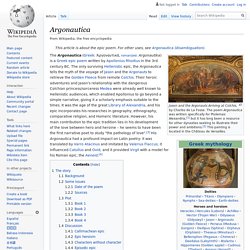
The poem Argonautica was written specifically for Ptolemaic Alexandria,[1] but it has long been a resource for other dynasties seeking to illustrate their power and ambitions.[2] This painting is located in the Château de Versailles. Argonauts. A band of heroes in Greek mythology We ask you, humbly, to help.

Hi, reader in Canada, it seems you use Wikipedia a lot; that's great! It's a little awkward to ask, but this Tuesday we need your help. Time is running out in 2019 to help us. We’re a non-profit and we don't have salespeople. Thank you! Amphora. Type of storage container An amphora (; Ancient Greek: ἀμφορεύς, amphoreús; English plural: amphorae or amphoras) is a type of container[1] of a characteristic shape and size, descending from at least as early as the Neolithic Period.
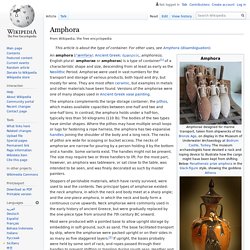
Amphorae were used in vast numbers for the transport and storage of various products, both liquid and dry, but mostly for wine. They are most often ceramic, but examples in metals and other materials have been found. Versions of the amphorae were one of many shapes used in Ancient Greek vase painting. The amphora complements the large storage container, the pithos, which makes available capacities between one-half and two and one-half tons. Aegina. Place in Greece Administration[edit] Municipality[edit] Kypseli (2124)Mesagros (1361)Perdika (823)Vathy (1495) The capital is the town of Aegina, situated at the northwestern end of the island.
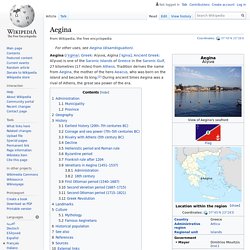
Due to its proximity to Athens, it is a popular vacation place during the summer months, with quite a few Athenians owning second houses on the island. Anafi. Place in Greece History[edit] Remains of the temple of Apollo Aigletes, Zoodochos Pigi Monastery According to mythology, the island was given the name Anafi because Apollo made it appear to the Argonauts as a shelter from a bad storm, using his bow to shed light upon it (i.e. the island name Ἀνάφη is derived from ἀνέφηνεν, "he made appear").[5] If the name of the island derives from this word, and means "revelation", then Anafi is linked to Delos, an island whose name also derives from an ancient Greek word meaning "to reveal".
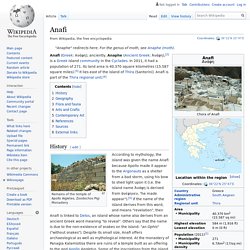
Others say that the name is due to the non-existence of snakes on the island: "an Ophis" ("without snakes"). Despite its small size, Anafi offers archaeological as well as mythological interest. Talos. Biography[edit] The death of Talos depicted on a 5th-century BCE krater now in the Jatta National Archaeological Museum in Ruvo di Puglia.
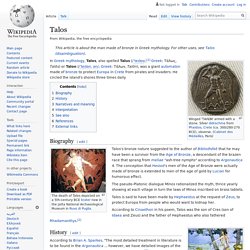
The pseudo-Platonic dialogue Minos rationalized the myth, thrice yearly showing at each village in turn the laws of Minos inscribed on brass tablets. Talos is said to have been made by Hephaestus at the request of Zeus, to protect Europa from people who would want to kidnap her. According to Cinaethon in his poem, Talos was the son of Cres (son of Idaea and Zeus) and the father of Hephaestus who also fathered Rhadamanthys.[2] History[edit] According to Brian A.
Narratives and meaning[edit] Crete. The largest and most populous of the Greek islands Crete (Greek: Κρήτη, Kríti ['kriti]; Ancient Greek: Κρήτη, Krḗtē) is the largest and most populous of the Greek islands, the 88th largest island in the world and the fifth largest island in the Mediterranean Sea, after Sicily, Sardinia, Cyprus, and Corsica.

It bounds the southern border of the Aegean sea. Crete lies approximately 160 km (99 mi) south of the Greek mainland. It has an area of 8,336 km2 (3,219 sq mi) and a coastline of 1,046 km (650 mi). Karpathos. Place in Greece Geography[edit] Map of Karpathos (Scarpanto), by Giacomo Franco, 1597 The island is located about 47 kilometres (29 miles) southwest of Rhodes, in the part of the Mediterranean which is called the Carpathian Sea (Latin: Carpathium Mare).
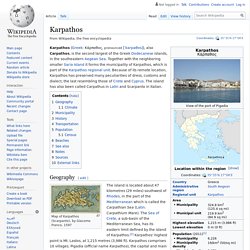
The Sea of Crete, a sub-basin of the Mediterranean Sea, has its eastern limit defined by the island of Karpathos.[2] Karpathos' highest point is Mt. Lastos, at 1,215 metres (3,986 ft). Santorini. A volcanic island in the southern Aegean Sea Place in Greece The island was the site of one of the largest volcanic eruptions in recorded history: the Minoan eruption (sometimes called the Thera eruption), which occurred about 3,600 years ago at the height of the Minoan civilization.[4] The eruption left a large caldera surrounded by volcanic ash deposits hundreds of metres deep.
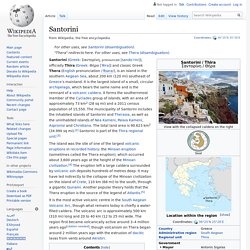
Perseus. Ancient Greek hero and founder of Mycenae Etymology[edit] Because of the obscurity of the name "Perseus" and the legendary character of its bearer, most etymologists presume that it might be pre-Greek; however, the name of Perseus' native city was Greek and so were the names of his wife and relatives.
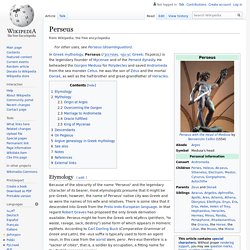
There is some idea that it descended into Greek from the Proto-Indo-European language. Triton. Triton commonly refers to: Triton may also refer to: Places[edit] Natural[edit] Triton Bay, an Arctic waterway in Qikiqtaaluk Region, Nunavut, CanadaTriton Bay, Kaimana, West Papua, IndonesiaTriton Island, a Paracel Island in the South China SeaTriton Point, a point on the east coast of Alexander Island, AntarcticaTriton River, a river flowing into Lake Copais, Greece. Hesperides. Gulf of Sidra. A body of water in the Mediterranean Sea on the northern coast of Libya Gulf of Sidra (Arabic: خليج السدرة, Khalij as-Sidra; Italian: Golfo di Sidra) or Gulf of Sirte (Arabic: خليج سرت, Khalij Surt; Italian: Golfo della Sirte), after the port of Sidra,[2] is a body of water in the Mediterranean Sea on the northern coast of Libya. Historically it has been also known as the Great Sirte or Greater Syrtis (Latin: Syrtis Major, Greek: Σύρτις μεγάλη, contrasting with Syrtis Minor in Tunisia).[3] Geography[edit]
Gulf of Sidra. Libya. Country in north Africa Libya (; Arabic: ليبيا, romanized: Lībiyā), officially the State of Libya,[dubious ][6][7][8][9] is a country in the Maghreb region in North Africa, bordered by the Mediterranean Sea to the north, Egypt to the east, Sudan to the southeast, Chad to the south, Niger to the southwest, Algeria to the west, and Tunisia to the northwest.
The sovereign state is made of three historical regions: Tripolitania, Fezzan and Cyrenaica. With an area of almost 1.8 million square kilometres (700,000 sq mi), Libya is the fourth largest country in Africa, and is the 16th largest country in the world.[10] Libya has the 10th-largest proven oil reserves of any country in the world.[11] The largest city and capital, Tripoli, is located in western Libya and contains over one million of Libya's six million people.[12] The second-largest city is Benghazi, which is located in eastern Libya. Libya has been inhabited by Berbers since the late Bronze Age. Oricum. Coordinates: Oricum or Orikon (Ancient Greek: Ὤρικον) or Oricus or Orikos (Ancient Greek: Ὤρικος or Ὠρικός) was an ancient Greek city[1][2][3] in the northern part of Epirus (modern south Albania), at the south end of the Bay of Vlorë. The city is an Archaeological Park of Albania. History[edit] But as soon as Caesar had landed his troops, he set off the same day for Oricum: when he arrived there, Lucius Torquatus, who was governor of the town by Pompey's appointment, and had a garrison of Parthinians in it, endeavored to shut the gates and defend the town, and ordered the Greeks to man the walls, and to take arms.
But as they refused to fight against the power of the Roman people, and as the citizens made a spontaneous attempt to admit Caesar, despairing of any assistance, he threw open the gates, and surrendered himself and the town to Caesar, and was preserved safe from injury by him. Orician terebinth ("Oricia terebintho") is mentioned by Virgil[13] and Sextus Propertius.[14] Ceraunian Mountains. The Ceraunian Mountains (Albanian: Malet e Vetëtimës,[1] "Thunderbolt mountains"; Greek: Κεραύνια Όρη, Keravnia ori; Latin: Cerauni Montes), also commonly Akroceraunian Mountains (Ancient Greek: Ἀκροκεραύνια, Albanian: Malet Akrokeraune[1]), are a coastal mountain range in southwestern Albania, within the county of Vlorë.
The range rises on the northeastern bank of the Ionian Sea. It extends for approximately 100 km (62 mi) in a southeast-northwest direction near Sarandë along the Albanian Riviera nearby to Orikum. Macris. In Greek mythology, Macris (Ancient Greek: Μακρις means "far away, blessed") was a daughter of Aristaeus and Autonoe. She gave newborn Dionysus honey to eat on Euboea after Hermes saved him. Macris was expelled from Euboea by Hera as punishment. Macris fled to a cave on a small island where she was helped by the goddess Demeter. Titan (mythology) Demeter. Uranus. Cronus. Macris. Scheria. Scheria or Scherie (; Ancient Greek: Σχερία or Σχερίη), also known as Phaeacia (), was a region in Greek mythology, first mentioned in Homer's Odyssey as the home of the Phaeacians and the last destination of Odysseus in his 10-year journey before returning home to Ithaca. From Ogygia to Scheria (Odysseus)[edit] Odysseus meets Nausicaa[edit]
Alcinous. Greek mythical character. Corfu. Planctae. Charybdis. Scylla. Trapani. Sirenum scopuli. Siren. Eryx. Empedocles. Anaximander. Circe. Mount Circeo. Aeaea. Elba. Îles d'Hyères. Asclepius. Heliades. Phaethon. North Sea. Ligurian Sea. Rhône. Rhine. Po. Eridanus. Hyllus. Šibenik. Hyllus. Hyllus. Colchis. Argonauts. Strabo. Herodotus. Po. Ceraunian Mountains. Pula. Harmonia. Absyrtus. Istria. Adriatic Sea. Kvarner Gulf. Danube. Danube Delta. Chilia branch. Hecate. Kızılırmak River. Sesostris. Herodotus. Aeëtes. Cadmus. Thebes. Colchis. Mossynoeci. Giresun Island. Themiscyra. Sinope. Sinop, Turkey. Actor. Sthenelus. Lycus. Heraclea Pontica. Thriae. Paean. Hyperborea.
Symplegades. Thynias. Kea (island) Aristaeus. Strofades. Etesian. Harpy. Phineus. Castor and Pollux. Bosporus. Thynia. Bebryces.